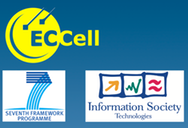The aim of the project was to establish a novel basis for future adaptive embedded information technology at the molecular level by constructing the first electronically programmable chemical cells (ECCells). The novel chemical microprocessor technology required to do this has also provided a programmable real-time interface to control other complex chemical information systems. Chemical cells are microscopically contained synthetic chemical systems in which the reactions occurring are directed by informational molecules and self-sustaining as in living cells. They should combine the three core architectural features of living cells: a hereditary information system, a containment system and a metabolic system that produces necessary energized components. Electronic chemical cells interface a microscopic self-regulating electronic subsystem with each microscopic chemical system via microelectrode arrays, with the impact that digital electronic information, in addition to genetic molecular information, can control them.
Extensions of DNA chemistry have allowed its function without enzymes and in containment and metabolic capacities: thereby simplifying the chemical integration process for constructing cells. The project has developed novel redox-active and pH sensitive replication chemistry based on sulfhydryl ligation and on ion-sensitive DNAzymes. Secondly, it has developed novel DNA-block copolymer hybrid molecules that self-assemble into containment structures, obviating the need for lipid membranes for ECCells. Some of these have surfactant properties like lipids, others reversibly control molecular mobility by modulating the attachment of specific DNA to polymer gel supports. Thirdly, the project has developed electrochemical subsystems that allow the reversible uptake and release of H+, metal cations as well as small metabolites and has shown how electrical control of processes involving DNA can thereby be achieved. As “hardware” the project has developed the electronic microfluidic chips and their chemical, optical and electronic interfaces and the integrated workstation platform. Each of the three chemical subsystems has separately been integrated into the microscopic electronic chemical cell processing system, and tested there using fluorescence imaging to feedback information to the electronic system. Three levels of electrode array integration were investigated to support increasingly fine grained ECCells: single layer electrode arrays, dual layer electrode arrays and active matrix electrode arrays based on LCOS displays, with the former two levels reaching fruition in the project.
The project also developed novel simulation and control software. The ECCell project has investigated multiscale particle simulations linking molecular properties with reaction-transport and self-assembly of critical subsystems and the overall cell-cycle, it has developed an efficient general purpose simulator for the integrated nonlinear electrochemical transport equations and it has integrated a particle tracer simulator with the experimental autonomous control system software, to allow an interpretation of online imaging data streams arising during the operation of electronic chemical cells. Finally, a general purpose local feedback control system has been implemented that will in future allow the complete integration of all chemical subsystems into electronic chemical cells. Ultimately, the ability of the chemical systems to synthesize information-rich components will also allow the electronic subsystems themselves to be repaired and copied, enabling the true integration of electronics production and their deployment as embedded systems. The ethical and social implications of this have also been investigated as part of a systematic policy of responsible engagement.
An international team from Germany (2), Israel, The Netherlands, Denmark, and Italy has pioneered this development, publishing widely in peer reviewed journals and contributing to a series of ongoing projects and coordination actions for the chem/bio ICT area. The work has been covered in press reports and is the subject of summer schools and ongoing dissemination. It was cooperatively and efficiently managed by the Ruhr University Bochum.
